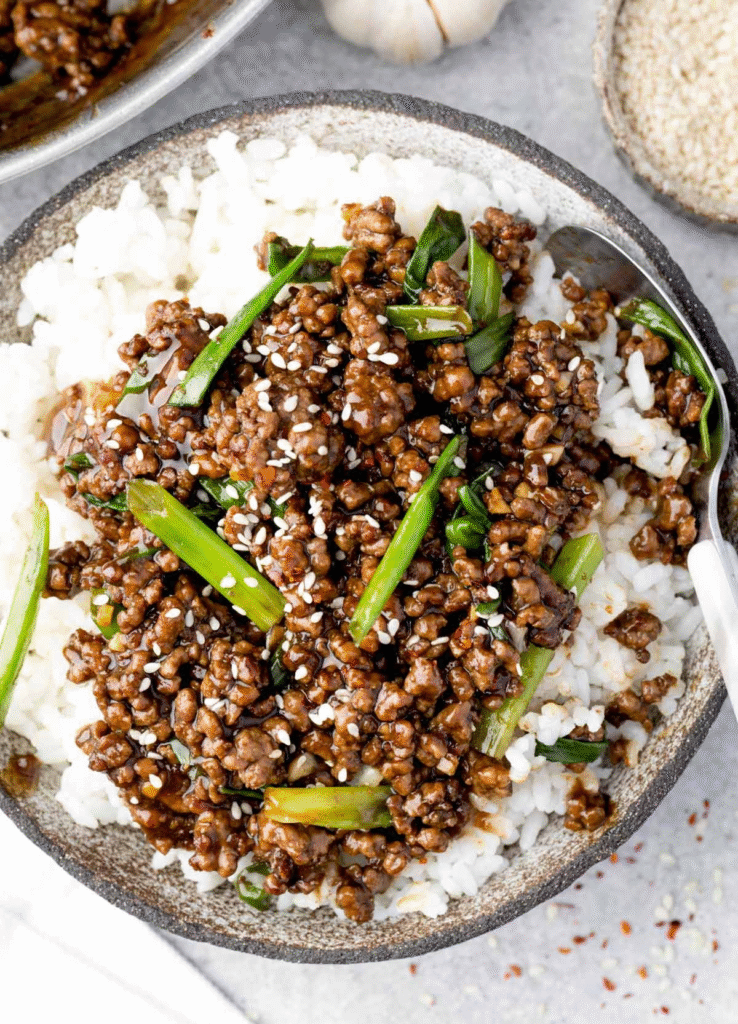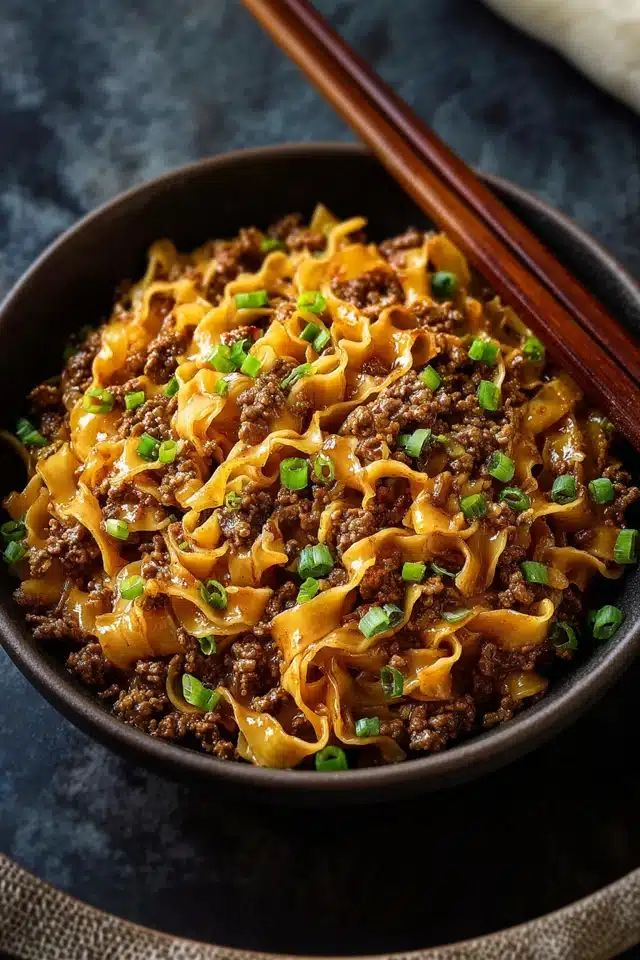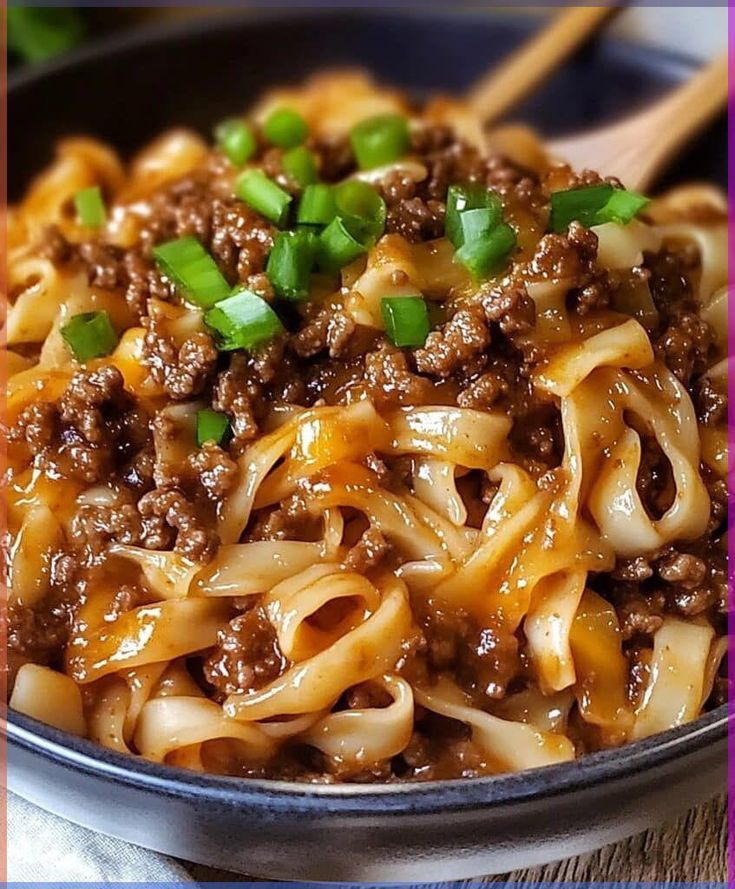This dish is built for speed without sacrificing depth. You’re working with ground beef instead of sliced steak, which means:
- No marinating time — the seasoning happens in the pan.
- Faster cooking — ground beef browns in minutes.
- Budget-friendly — still delivers big flavor without expensive cuts.
Plus, the sauce does the heavy lifting. It’s salty from soy, sweet from brown sugar, aromatic from garlic and ginger, and thick enough to coat every crumbled piece of beef. Think of it as the weeknight cousin of Mongolian beef from a Chinese restaurant — less formal, just as delicious.
Ingredients You’ll Need
Before you start, get everything on the counter. When you’re racing the clock, organization saves you more time than rushing ever will.
Core ingredients:
- 1 pound (450g) ground beef — 80/20 blend works best for flavor and tenderness.
- 1/2 cup low-sodium soy sauce — salty umami base without overpowering.
- 1/2 cup brown sugar — balances saltiness and gives that sticky glaze.
- 1 tablespoon fresh ginger, minced — for a warm, peppery kick.
- 4 cloves garlic, minced — the soul of the sauce.
- 1/4 cup water — helps dissolve sugar and prevents sauce from burning.
- 2 teaspoons cornstarch — thickens the sauce to coat the beef.
Optional flavor boosters:
- Red pepper flakes for a bit of heat.
- Sesame oil for a nutty aroma.
- Green onions for a fresh finish.
- Steamed broccoli or snap peas for a veggie boost.
Choosing the Right Ground Beef
This isn’t the time to grab the leanest meat in the store. You want at least 15–20% fat content. Here’s why:

- Fat carries flavor, making the beef rich and juicy.
- Lean beef can turn grainy and dry after browning.
- A little rendered fat in the pan helps the sauce cling to every morsel.
If you must use lean beef, add a teaspoon of oil during cooking to make up for the lost richness.
Step-by-Step Cooking Instructions
Here’s how to hit that 25-minute sweet spot without skipping any flavor.
1. Brown the Beef
Heat a large skillet over medium-high heat. Add the ground beef, breaking it up with a spatula. Don’t stir constantly — let it sit for 30–40 seconds at a time so it develops a bit of a crust before moving it around. Browning equals flavor.
Once it’s mostly cooked, drain excess fat if there’s a lot, but leave 1–2 teaspoons in the pan.

2. Add Aromatics
Lower the heat to medium. Push the beef to one side and add ginger and garlic to the empty space. Stir for 30 seconds until fragrant — this is your flavor foundation. Then mix them into the beef.
3. Make the Sauce
In a small bowl, whisk soy sauce, brown sugar, water, and cornstarch until smooth. Pour this mixture into the pan. Stir well, letting it bubble and thicken for 2–3 minutes. You’ll know it’s ready when the sauce clings to the beef instead of pooling at the bottom.
4. Adjust and Finish
Taste and adjust — add more sugar for sweetness, soy sauce for salt, or water if it’s too thick. Sprinkle in green onions and a drizzle of sesame oil if you want extra depth.
The Science Behind the Flavor
Mongolian beef’s appeal comes from flavor contrast. You’re hitting the tongue with salty, sweet, umami, and a bit of heat all at once. The soy sauce delivers glutamates (the natural compound behind umami), while sugar balances salt and creates a glossy finish. Garlic and ginger add volatile compounds that your brain instantly registers as “delicious” the second the aroma hits.

The cornstarch isn’t just for thickness — it helps the sauce cling so you get flavor in every bite instead of it sliding off into the rice.
Serving Ideas
Sure, rice is the classic pairing, but don’t stop there. This beef plays well with:
- Steamed jasmine or basmati rice — absorbs the sauce perfectly.
- Rice noodles or lo mein — toss the beef directly in.
- Lettuce wraps — low-carb option that still tastes indulgent.
- Mashed potatoes — fusion comfort food at its best.
I’ve even spooned it over roasted sweet potatoes for a sweet-salty combo that shouldn’t work but absolutely does.
How to Make It a Balanced Meal
The beef and sauce are flavor bombs, but for a complete plate:

- Add steamed broccoli, green beans, or bok choy to the skillet in the last 3 minutes.
- Serve with a side salad dressed in sesame vinaigrette.
- Use brown rice or quinoa for extra fiber.
Not only does this round out the nutrition, it also makes the dish stretch further — great for meal prep.
Meal Prep and Storage
This recipe reheats beautifully, making it a go-to for busy weeks.
- Fridge: Store in an airtight container for up to 4 days.
- Freezer: Cool completely, then freeze for up to 2 months. Thaw in the fridge overnight before reheating.
Tip: If reheating in the microwave, splash in a teaspoon of water to keep it from drying out.
Cooking in Batches
If you double the recipe, don’t overcrowd the pan. Browning works because heat can circulate — pack the beef in too tight and it steams instead of sears. Cook in two batches, then combine everything before adding the sauce.
Nutritional Breakdown
Here’s the approximate nutrition per serving (4 servings, without rice):

- Calories: 310
- Protein: 21g
- Fat: 16g
- Carbohydrates: 19g
- Sodium: 850mg (use low-sodium soy to cut this)
For a healthier version, you can:
- Use leaner beef and add a splash of olive oil for flavor.
- Swap half the sugar for honey.
- Load up on vegetables to dilute calorie density.
Common Mistakes to Avoid
Even simple recipes have pitfalls. Watch out for:
- Burning garlic — it goes from fragrant to bitter fast. Always add it after beef is mostly cooked.
- Sauce too runny — use the right cornstarch ratio and give it time to thicken.
- Too salty — start with low-sodium soy; you can always add salt later.
- Overcooking beef — keep it tender by stopping once it’s fully browned, not bone-dry.
Why This Recipe Beats Takeout
Restaurant Mongolian beef often comes with:
- Over-salted sauce.
- High oil content.
- More sugar than needed.
Making it at home gives you control over every element. You get the same bold flavor, but lighter and fresher — and you can have it on the table before delivery would even arrive.
Variations to Try
Once you’ve mastered the base recipe, tweak it to keep things interesting:

- Spicy Mongolian Beef: Add 1 tablespoon chili paste.
- Mongolian Turkey: Swap ground beef for ground turkey.
- Coconut Twist: Add 1/4 cup coconut milk to the sauce for creaminess.
- Sticky Mongolian Meatballs: Form beef into balls, bake, then toss in sauce.
Final Thoughts
The beauty of Mongolian ground beef is how fast, flexible, and flavor-packed it is. In under half an hour, you’ve got a dish that tastes like you put in triple the effort. It’s the perfect example of how a smart sauce, the right protein, and a bit of cooking know-how can turn an ordinary dinner into something you’ll want to make again and again.
Once you’ve made it a couple of times, you’ll have the timing down so well you could probably whip it up with one hand while texting with the other — though I recommend focusing on the cooking if you want it perfect.







